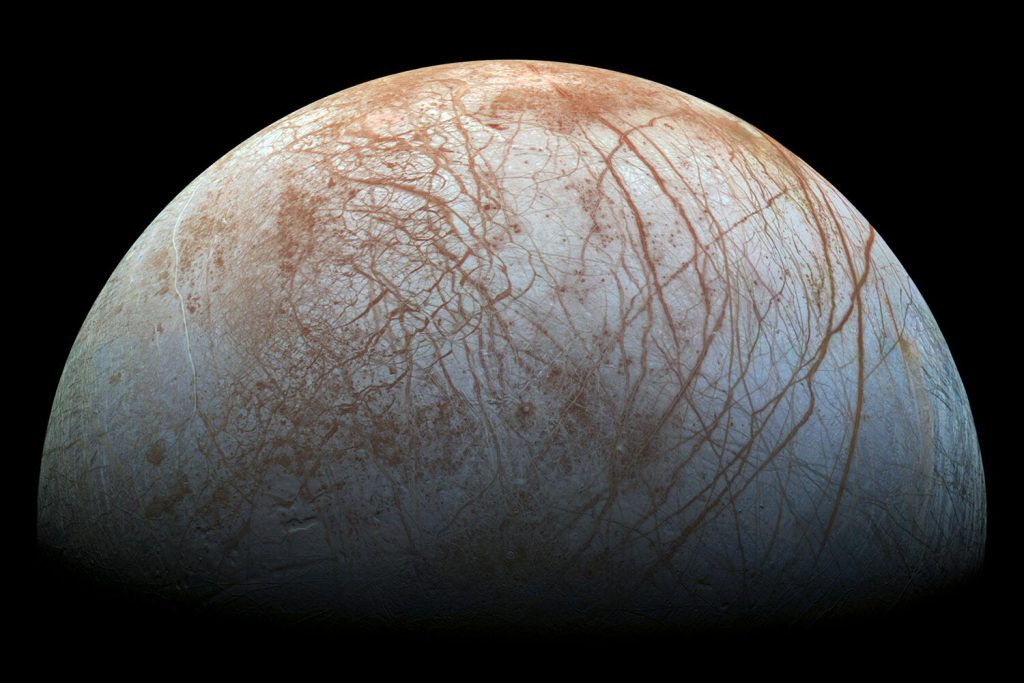On Oct. 14 NASA’s Europa Clipper Mission launched. It is the first detailed investigation of Jupiter’s moon Europa—which is believed to harbor an ocean so vast that it contains more water than anywhere else in the known universe (even Earth). While the mission won’t directly search for life, everywhere water has been found on Earth, life has been present.
Europa’s ocean is thought to lie beneath the moon’s icy surface, which is why Clipper includes ice-penetrating radar, called Radar for Europa Assessment and Sounding: Ocean to Near-surface (REASON). This instrument will probe the ice for evidence of an ocean while also capturing other information about the ice itself, such as thickness and structure. REASON will also map Europa’s surface topography and composition and look for water plumes emerging from the ice.
Dustin Schroeder, associate professor of geophysics and of electrical engineering and an expert in using radar to assess glaciers, is a member of the REASON science team—a journey that dates back to his Ph.D. work at the University of Texas with Donald Blankenship, leader of the Clipper radar team.
“If you told 18-year-old me I’d be going to Cape Canaveral to watch the launch of a NASA Flagship Mission, that I was part of both the science and engineering of, I think I’d be beside myself with joy and disbelief,” said Schroeder.
NASA makes it clear that ‘Europa Clipper is not a life detection mission.’ But could it tell us anything about extraterrestrial life?
That’s true. It’s a “habitability” focused mission. The instruments on the spacecraft and the investigations we’ll conduct are focused on exploring and understanding the conditions and processes that govern the evolution and behavior of Europa, its ice shell, and its subsurface ocean.
Once we have a better understanding of Europa, we’ll be able to more effectively assess its general habitability and target follow-on missions that would try to detect potential life in the places it’s most likely to exist.
In your opinion, what would be the most exciting outcome of this mission?
Of course, like everyone on the mission, I am excited about the possibility that we’ll detect a pocket of potentially habitable water within the relatively shallow portion of the ice shell. But, as a radio glaciologist and radar engineer, I’m also totally thrilled to see how our dual-frequency, dual-channel interferometric ice-penetrating radar data looks.
There are a lot of really creative things that we’re planning to do with REASON that are first-of-their-kind from a planetary radar point of view. So, I think it stands to be a transformative mission from both a scientific and an engineering perspective. Which is my favorite!
How does this work relate to research you’ve done on Earth?
My research group is focused on “Radio Glaciology,” which spans the science and engineering of ice-penetrating radar. On Earth, my students and I develop ice-penetrating radar systems and collect and analyze data to understand the evolution, behavior, and sea level contributions of ice sheets and glaciers.
As part of the Europa Clipper Science Team, we’re doing the same kind of science and engineering work, just focused on using ice-penetrating radar to investigate the processes, conditions, and habitability of Europa’s ice shell.
Is there anything this study of Europa could tell us about Earth?
The work we’ve done to prepare for Europa Clipper has already made major contributions to our terrestrial work.
We’ve developed a passive radar sounding approach using the sun as a radio noise source to probe the subsurface of the Greenland Ice Sheet. We’ve discovered a surface melt refreezing and fracture process at play in the shallow firn layer—a layer of ice from a previous season that has refrozen and is characteristically in between glacial ice and snow—across Greenland.
And we’re developing joint-analysis processes for active radar sounding and passive radiometer data to measure the top-to-bottom temperature profile of ice sheets. All of these are the direct outgrowth of work we’re doing for Europa Clipper. It’s an amazing interdisciplinary flow of ideas and techniques.
Provided by
Stanford University
Penetrating the ice sheet of an ocean moon: Four questions about the Clipper Mission to Europa (2024, October 15)
retrieved 17 October 2024
from https://phys.org/news/2024-10-penetrating-ice-sheet-ocean-moon.html
part may be reproduced without the written permission. The content is provided for information purposes only.

